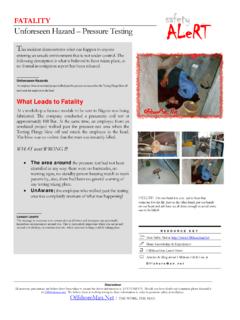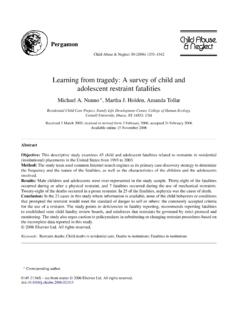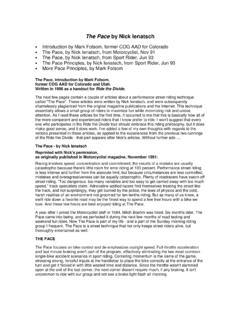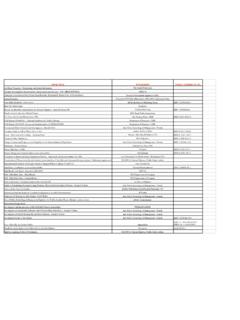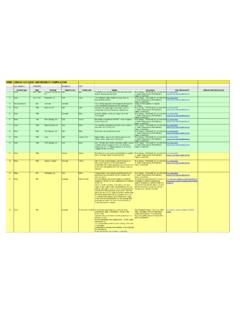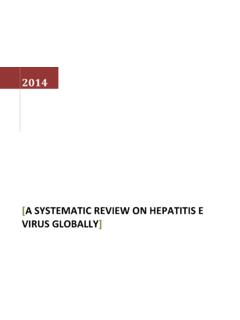Transcription of Lead poisoning in a historical perspective - rachel.org
1 AMERICAN JOURNAL OF INDUSTRIAL MEDICINE 38:244 254 (2000) lead poisoning in a historical PerspectiveSven Hernberg,MD,PhDLead poisoning existed and was already known in Antiquity but was forgotten, at least inthe literature, until the end of the Middle Ages, where it was mentioned sporadically. Inthe 19th century this disease, which reached epidemic dimensions during the period ofindustrialization, was ``rediscovered.'' Several comprehensive clinical articles appearedin the literature. The clinical picture deepened during the beginning of the 20th century,and preventive efforts were started. However, the concept of poisoning remained strictlyclinical. During the latter half of the 20th century a new concept emerged: subclinicaland early forms became recognized as undesirable effects.
2 This led to a substantiallowering of hygienic standards. Pediatric poisoning has also been a serious problemduring the 20th century. After the 1920s, environmental pollution by lead caused by theintroduction of tetraethyl lead in gasoline became an alarming public health use became restricted in the 1980s; its effects on blood lead levels are now 's research focuses on the effects of low exposure, often with the aim of de ningnoneffect levels for different types of J. Ind. Med. 38:244 254, Wiley-Liss, WORDS: hematology; neurotoxicity; nephrotoxicity; subclinical effects;occupational exposure; air pollution; tetraethyl lead; childhood lead poisoning ;blood lead concentrationINTRODUCTIONLead has been mined and used by mankind for 6,000years, and the history of lead poisoning is nearly 2,500 yearsold.
3 Summarizing such a long story in a few pages in abalanced way is impossible. The older history of leadpoisoning has been reviewed many times in articles, bookchapters, and textbooks [ , Cantarow and Trumper, 1944,Hernberg, 1975, Hamilton and Hardy, 1983, Nriagu, 1983,Hunter, 1988]. This review focuses on recent history,especially prevention, the new concept of poisoning , andon some of the controversies involved in studying, de ning,and preventing lead EARLY DAYSLead was known to man as early as 4,000 BC. Both theEgyptians and Hebrews used lead and the Phoeniciansmined lead ore in Spain around 2,000 BC. The earliestwritten accounts of lead toxicity have been found inEgyptian papyrus scrolls.
4 According to them, lead com-pounds were often used for homicidal purposes. Hippo-crates, in 370 BC, was probably the rst to describe leadcolic, without however recognizing the etiology. The rst todescribe lead palsy was Nicander in the 2nd century BC, buthe too was not able to attribute the palsy to lead in the 1st century AD Dioscorides saw the connectionbetween lead exposure and toxic manifestations, and Plinystated that lead poisoning was common in shipbuilding. TheRomans produced an average of 60,000 tonnes of lead a yearfor 400 years. They used lead compounds for glazingpottery, and metallic lead for cooking utensils and also used to boil and condense grape juice in leadpots for preserving and sweetening of wine.
5 Lead poisoningfrom all these sources must have been common in ancientRome. The poisoning was epidemic and is said to haveFinnish Institute of Occupational Health, Helsinki,Finland*Correspondence to: Sven Hernberg, Kuusisaarenpolku 4a, FIN-00340 Helsinki, : fiAccepted 20 February 2000fl 2000 Wiley-Liss, , ,ithasbeensuggestedthatwidespreadleadpoi soning,selectivelyaffectingthepatricians whodrankmuchwineandhadaccesstoplumbing,c ontributedtothedecadenceandlaterthefallo ftheRomanEmpire[Gil llan,1965].Indeed,highleadconcentrations havebeenfoundinarcheologicalRomanbones; , ,becauseleadwaswidelyusedbothforindustri al,domestic, ,leadacetate(``leadsugar'')wasusedasaswe etenerofwineandciders, , rstin1498andlaterin1577, (so-called)medicinalpreparationshelpedma nypatientstoabetterworldmorequicklythan` `normally.
6 ''Industriallyleadanditscompoundsgainedm oreandmoreuseatthebeginningoftheNewAge,f orexample,inpottery,piping,shipbuilding, windowmaking,thearmsindustry,pigments, ,16th,17th, ,itwasnotuntilinthe16thcenturythatleadpo isoningreappearedinthemedicalliteraturei nParacelsus'descriptionofwhathecalled``t heminer'sdisease.''Inthebeginningofthe18 thcenturyRamazziniwrotethatpotterswhowor kedwithleadbecame``paralytic,splenetic,l ethargic,cachectic,andtoothless,sothaton erarelyseesapotterwhosefaceisnotcadavero usandhasthecoloroflead''[Ramazzini,1713] .SirGeorgeBakermadeanimportantobservatio nin1767[Baker,1772].Heunderstoodthatthes o-calledDevonshirecolic,whichhadplaguedt hecountyforacentury, ;hencehecouldprovethattheetiologyoftheco licwasleadpoisoning,notstardustoreastern wind, ,encephalopathy,pallorandabdominalcramps , ,butitwasnotuntilwellintothe19thcenturyt hatsigni ANEPIDEMICOFLEADPOISONINGIn1831 Laennecdescribedtheanemiaofleadpoisoning andin1832 Thackrahpublishedaclinicaldescriptionofl eadpoisoning(``plumbism'') rst``modern''clinicaldescriptionofleadpo isoningwasTanquereldesPlanches'famous``T raite desmaladiesdeplombousaturnines,''whichap pearedin1839andwasbasedonover1, andprobablynoonelater, ,neurological,andarthriticaspectsofleadp oisoning,butheerroneouslybelievedthatthe yweredifferententities[Hunter,1988].
7 ,whichispartlyduetoanemia, ,in1899,wasthe ,thismethodwasneitherspeci cnorsensitive, rsttoreportincreasedexcretionofporphyrin sintheurineandin1934 ViglianiandAngeleri[citedbyHaeger-Aronse n,1960]demonstratedthattheincorporationo fironintohemewasimpaired, (ALA)intheurineofleadworkersin1960,andaf ewyearslaterBonsignoreandhiscoworkersdem onstratedthatleadinhibitedtheenzymedelta -amino-levulinicaciddehydratase(ALA-D),w hichexplainedtheincreasedALAexcretion[Bo nsignoreetal.,1965].Apartfrominhibitingh emesynthesis,leadshortensthelifespanofth eerythrocytes, [1951]werethe rsttoreportthismechanism, , ,leadblindnessstruckmanypatientsinthebeg inningofthe20thcentury[ ,Gibson,1908;Prendergast,1910;citedbyHam iltonandHardy,1983].
8 Leadencephalopathy,togetherwithanemia,wa salsoaprominentmanifestationoftheseveree pidemicsofchildhoodleadpoisoningthathadp robablyoccurredforlong,butwere ,thesevere,clinicalformsofnervoussystemi nvolvementweretheonlyonesthatcountedearl ier,butinthe1970ssubclinicalmanifestatio nsofperipheral[Seppa -la inenandHernberg,1972]andcentralnervoussy steminvolvementinindustrialworkers[Ha nninenetal.,1978] [1972]hasdescribedleadcolicascharacteriz edby``sharponsetandrecurrentspasmsinwhic hthepatientwrithesinpain,retractshislegs spasmodicallytohisabdomen,groans,clenche shishands,gritshisteeth,withbeadsofsweat onhisbrow.'' ,217patientscomplainedofjointpainandGarr oddescribed``leadgout''in1854[Hamiltonan dHardy,1983].
9 Also,laterclinicalstudiescon rmthatjointpainiscommoninclinicalpoisoni ng[Linenthal,1924,Mayers,1927,citedbyHam iltonandHardy].EarlystudiesfromQueenslan d,Australia, [Nye,1929;HendersonandInglis,1957].Also, industrialworkers,heavilyexposedduringth e rsthalfofthe20thcentury,haveshownrenalin volvement,characterizedbydiffuseintersti tial ,heavyusersofleadcon-taminated``moonshin e''whiskeyusedtosufferfromprogressiveren aldisease,saturninegout, , ,andiftheybecamepregnant,theriskofstillb irthwasmuchhigherthanforwomennotsoexpose d[Oliver,1911,citedbyHamiltonandHardy,19 83].Also,themortalityoftheirchildrenduri ngthe rmtheseeffectsofleadonpregnancyoutcome[H amiltonandHardy,1983]. [Paul,1860,citedbyHamiltonandHardy,1983] .
10 Theseoldstudiesseemoftentohavebeenforgot tenwhentoday'sresearchers``redetect''adv ersepregnancyoutcomeinmoderatelyexposedw orkers assuchnonew nding, ,thisdiseasewasoftenfatal; ,butitsincidencemusthavebeenveryhighforc enturies, ,1875 1900,about30,000casesofleadpoisoningwere reportedfromtheleadminesofUtahalone;more than1, [Hernberg,1975].Thereisnoreasontobelieve thatthesituationontheEuropeancontinentwa sbetter;thesystemofreportingwasweaker, ,scrapping,theprintingindustry,thepotter yindustryand,later, , , ,SirThomasMorrisonLeggebecamethe , ``LeadPoisoningandLeadAbsorption''[Legge andGoadby,1912].ThankstoLegge'sandtheIns pectorate'sactivities,thenumberofnoti edcasesofleadpoisoningdroppedfrom1058in1 900(58fatal)to41in1944(5fatal)[LloydDavi es,1957].


